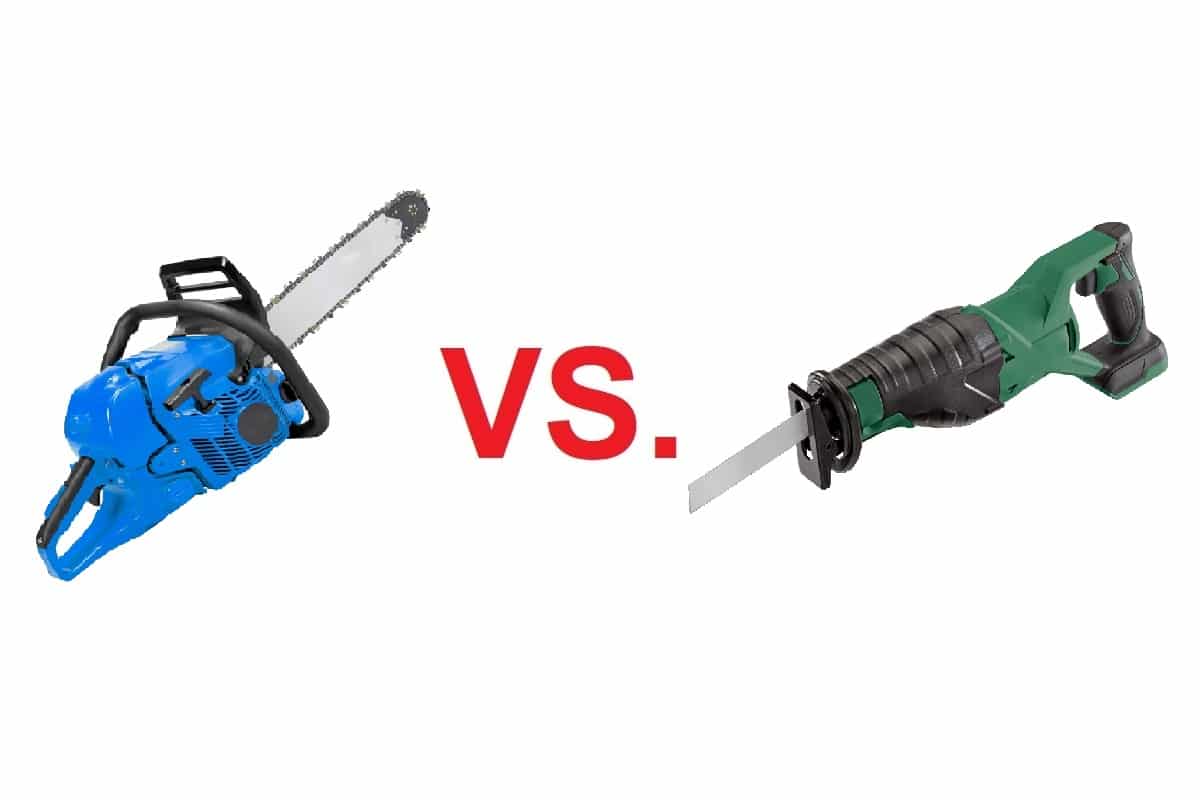A chainsaw and reciprocating saw belong in the same category of saws and work alongside other tools used on construction projects. They’re both arguably essential tools for home improvement and woodworking. But what are the differences (and similarities) between chainsaws and reciprocating saws? You can find out in this post.
Chainsaws vs. Reciprocating Saws
Similaries Between Chainsaws And Reciprocating Saws
Both chainsaws and reciprocating saws can cut through various types of wood and drywall, along with metal and concrete. Each has different types and sizes of blades for various cutting tasks.
- Both can be cordless if electric-powered and be run by a battery.
- Both come in different sizes, from small to large with corresponding long or short bar and blade lengths.
- Both have grips and triggers to hold and run the saw.
- Both are designed to be held with two hands with one on the trigger and the other on the grip or forward handle. It is possible to use only one hand with a small chainsaw or reciprocating saw, but this is not safe.

Materials both chainsaws and reciprocating saws can cut:
- Wood
- Metal
- Concrete
- Plastic
- Bone
- Plasterboard
- Brick or concrete blocks
- Fiber Cement
- Epoxy Resin
Differences Between Chainsaws and Reciprocating Saws
Reciprocating saws are meant for general purpose cutting and can be used to cut metal or wood. They are also great for cutting drywall, roofing materials, rope, flooring, and metal mesh wiring.
Chainsaws, however, are primarily made for cutting wood, tree branches, tree trunks, wood planks, and boards. Attempting to cut metal, rope, or wiring with a chainsaw could result in the breakdown of the chain or engine, along with potential injury from kickback.
Reciprocating saw blades can be used for multiple cutting purposes. The operator does not need to change out the blade if they are cutting through wood that has nails in it. Reciprocating saws also have blades that cut in a different way than chainsaws, in that the blade oscillates back and forth.
The blade of a reciprocating saw can be changed out much quicker and easier than a chainsaw chain. The blade has a special clip that attaches to the inside of the reciprocating saw and only needs a twist of the clamp with the user’s fingers to remove it.
A chainsaw, however, needs the two side bolts removed from the bar covering using a wrench and the chain tension lowered with a screwdriver to loosen it before removing it. Putting a new chain on means doing this process in reverse and making sure the chain is tight enough but not too tight to slide around the bar freely. In short, changing a chain saw chain is a more lengthy and involved process for the user.
Chainsaws are also much better than reciprocating saws at cutting very thick wood. You wouldn’t try to cut down a large tree with a reciprocating saw as the blade will not be long enough and the power output not high enough.
However, reciprocating saws are good at cutting various materials with different blades such as wood, metal, and plastic with just a standard reciprocating saw and quick-change blades. This means not having to use a large and expensive concrete saw with a diamond-studded blade.
Reciprocating saws are also easier to maintain than chainsaws. They do not need oil, calibrations, or adjustments to the bar or chain. If they are battery-operated, they only need to be recharged and cleaned occasionally.
Chainsaw Or Reciprocating Saw – Which Is Safer?
How Safe Are Chainsaws?
Chainsaws are very dangerous cutting tools that have a lot of power in their engines and run a very fast chain. But like other saws, they can be used safely by most individuals.
Modern chainsaws include certain safety features, such as
- Chain brake
- Front handle
- Throttle interlock
- Easy access On / Off switch
- Optional large chain protection guard
How Safe Are Reciprocating Saws?
Reciprocating saws are much safer than chainsaws because they are usually lower powered, and use shorter blades. However, a pointed reciprocating saw blade could still stab the operator if it is not pointed away from their body. A chainsaw chain and bar are longer and are thus more exposed to anything or anyone in its path. A running chainsaw is extremely dangerous, and only trained or experienced individuals should operate one. A reciprocating saw is more youth-friendly and someone under 18 years old can usually operate one quite safely while wearing the proper PPE.
Using a Chainsaw – How to Do It Safely
There are several key steps to keeping yourself safe while using a chainsaw. These are heavy and somewhat large power tools that can be difficult to control. Keep your hands away from the chain whether it is moving or not and always keep a tight grip on the handles.
Wearing safety gloves and goggles, as well as a chainsaw jacket and pants, will help keep you protected. This includes wearing steel toe boots which will protect your feet and toes from any sharp or heavy debris that could drop to the ground.
If you follow these safety recommendations, chainsaws can be a great tool to use.
